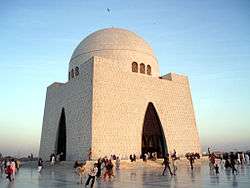Debal
| Part of a series on the |
| History of Karachi |
|---|
 |
| Ancient period |
| Islamic period |
| Local dynasties |
| British period |
| Independent Pakistan |
Debal (Sindhi: ديبل; Urdu: ديبل) was an ancient port located near modern Karachi, Pakistan.[1] It is adjacent to the nearby Manora Island and was administered by Mansura, and later Thatta. As per historian Rahimdad Khan Molai Shedai "Debal was one temple, situated now near Pir Pithho, in which one idol of Deval god was lying. Temple was situated at the center of the town. Sea weaves would hit against the wall of town. The highest dome of the temple would be seen at long distance from the sea. Temple had also four small domes at its four corners. One brass made statue of a man on the horse was affixed on the top of the large dome. A red flag was hoisted on a long bamboo post. It was belief of people of the town that until the flag was hoisted no body could conquer the town. Abu Zaid Serafi writes that in 294 Hijra religious prostitutes would live in the temples of Sindh. Naked Buddhist monks with long hair used to walk into the towns wearing garlands of skulls".[2]
Etymology
In Arabic history books, most notably in the early eighth century accounts of the arrival of Islam in the Indian Sub-continent, it was documented as Daybul (Dīwal ~ Dībal ديبل). One view is that the name was derived from Devalaya, meaning an abode of God in Sanskrit.
History
According to modern archaeologists, Debal was founded in the 1st century CE, and soon became the most important trading city in Sindh. The port city was home to thousands of Sindhi sailors including the Bawarij. Ibn Hawqal, a 10th-century writer, geographer and chronicler, mentions huts of the city and the dry arid land surrounding the city that supported little agriculture. He mentions how efficiently the inhabitants of the city maintained fishing vessels and trade. The Abbasids were the first to build large stone structures including a city wall and a citadel.
Debal and the Manora Island were visited by Ottoman Admiral Seydi Ali Reis (1498–1563) and mentioned in his book Mir'ât ül Memâlik in 1554. In 1568 Debal was attacked by the Portuguese Admiral Fernão Mendes Pinto (1509 – 1583) in an attempt to capture or destroy the Ottoman vessels anchored there. Fernão Mendes Pinto also claims that Sindhi sailors joined the Ottoman Admiral Kurtoğlu Hızır Reis on his voyage to Aceh. Debal was also visited by the British travel writers such as Thomas Postans and John Elliott. According to Eliot, who is noted for his vivid account on the city of Thatta, parts of city of Karachi and the island of Manora at port of Karachi constituted the city of Debal.
See also
References
Further reading
- Malcolm Robert Haig (1894). The Indus Delta Country: A Memoir, Chiefly on Its Ancient Geography and History. K. Paul, Trench, Trübner & Co. p. 42.